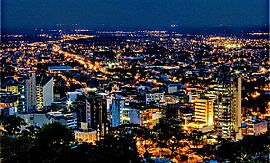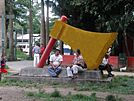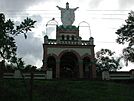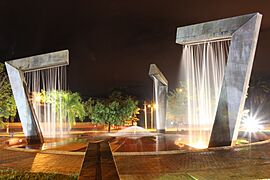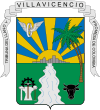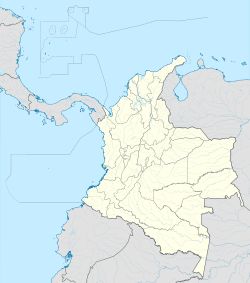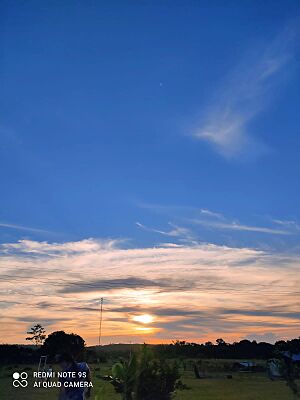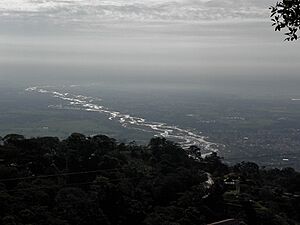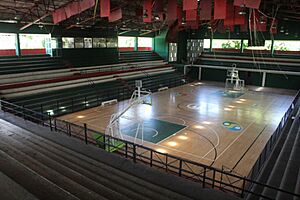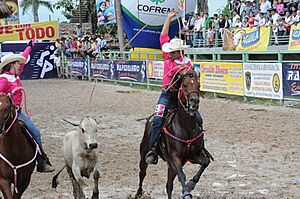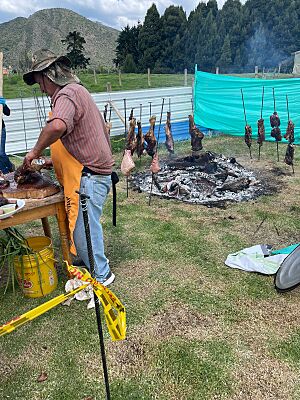Villavicencio facts for kids
Quick facts for kids
Villavicencio
|
|||
|---|---|---|---|
|
Municipality and city
|
|||
|
From the top: Panoramic view, The Axe Park, Christ the King Monument, The Harps Monument
|
|||
|
|||
| Nickname(s):
Puerta del Llano (Gate of the Plain)
Villavo la bella (Villavo the beautiful) La Capital de la tierra Llanera (The Capital of the Llanera Land) El Corazón del Este (The Heart of the East) |
|||
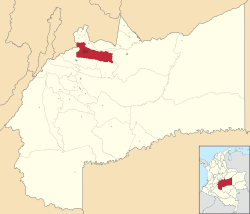
Location map of the municipality and city of Villavicencio in the Department of Meta.
|
|||
| Country | |||
| Region | Orinoquía | ||
| Department | |||
| Founded | 1840 | ||
| Area | |||
| • Municipality and city | 1,328 km2 (513 sq mi) | ||
| • Urban | 65.83 km2 (25.42 sq mi) | ||
| Elevation | 467 m (1,532 ft) | ||
| Population
(2018 Census)
|
|||
| • Municipality and city | 531,275 | ||
| • Density | 400.06/km2 (1,036.1/sq mi) | ||
| • Urban | 492,052 | ||
| • Urban density | 7,474.6/km2 (19,359.1/sq mi) | ||
| Demonym(s) | Villavicense | ||
| Time zone | UTC-05 (Eastern Time Zone) | ||
| Area code(s) | +57 (8) | ||
| Climate | Af | ||
| Website | Official website: http://www.semvillavicencio.gov.co/ | ||
Villavicencio is a big city and municipality in Colombia. It is the capital of the Meta Department. The city was started on April 6, 1840. In 2018, about 531,275 people lived there.
Villavicencio is located about 75 kilometers (45 miles) southeast of Bogotá, Colombia's capital. It sits by the Guatiquía River. This city is the most important trading hub in the Llanos Orientales, which are the Eastern plains of Colombia.
The city has a hot and very wet climate. Daily temperatures are usually between 21 and 30 degrees Celsius (70 to 86 degrees Fahrenheit). It gets a lot of rain each year, around 4500 mm (177 inches). People sometimes call it "Villavo la bella," which means "Villavo the beautiful."
Villavicencio is on the huge Colombian-Venezuelan plain called the Llanos. This area is east of the Andes mountains. It is also known as "La Puerta al Llano," or "The Gateway to the Plains." This is because it's on the old path from Colombia's mountains to the wide savannas. These savannas are found between the Andes and the Amazon rainforest.
Because Villavicencio is close to both huge mountains and vast plains, it shows Colombia's amazing geodiversity. The city is at the foot of the Andes. This means cool breezes blow in the mornings and evenings, which helps cool the city down.
Contents
- History of Villavicencio
- Geography of Villavicencio
- Rivers and Waterways
- Climate in Villavicencio
- Economy and Trade
- Education in Villavicencio
- Sports in Villavicencio
- Tourism and Attractions
- Festivals and Celebrations
- Parks to Explore
- Culture of Villavicencio
- Notable People from Villavicencio
- See also
History of Villavicencio
Early Explorers and Settlements
In 1536, a German explorer named Nikolaus Federmann reached the high plains of Bogotá. He came from the plains of Venezuela, which was a huge, empty area. But for the next 300 years, most of these plains remained unexplored.
Colombia was mainly settled along the mountain valleys of the Magdalena River and Cauca River. Trade with other countries happened through the Caribbean Sea. Because of the mountains, extreme heat, and tough climate, the Llanos were mostly forgotten for a long time.
The Llaneros and Independence
The Llaneros are the people who live on the plains. They are known as fierce horse riders. They first fought for the Spanish king. Later, they joined the rebels from Venezuela and Colombia during the War of Independence.
During Simón Bolívar's fight for freedom, the Llaneros crossed the Eastern Mountain Range. They surprised the royalist army on the plains of Boyaca on August 6, 1819. This victory opened the way for them to take Santa Fe de Bogotá the next week.
Founding the City
In the 1840s, some farmers from Caqueza started a small settlement called Gramalote. Caqueza is a town on the eastern side of Bogotá. Gramalote officially became the parish of Villavicencio in 1855.
The parish was named after Antonio Villavicencio. He was a hero in the Colombian war of independence. New roads and the chance to get free land encouraged more people to settle in Villavicencio. As roads got better, farmers could send their crops and cattle to markets in Bogotá.
Growth and Modern Times
In 1948, many farmers had to leave their lands across the country. This happened partly after a popular politician, Jorge Eliecer Gaitan, was killed. The Llaneros fought back and pushed the army out of many towns. The fighting never reached Villavicencio itself, but it did get close to the military base of Apiay.
The fighting between the government and the Llanero groups became very difficult to control. In June 1953, Gustavo Rojas Pinilla took power in a military change. He quickly worked to stop the fighting and offered forgiveness to those who had rebelled.
Villavicencio has grown a lot since then. From a small group of about 20 people in the 1850s, it became a city of over 500,000 people by 2018. A new road with bridges and tunnels has made the trip to Bogotá much shorter. Now, it takes about one and a half hours instead of two or three. This helps move oil, cattle, and farm products faster.
Geography of Villavicencio
The city is in the Orinoquia region, where the flat Eastern Plains begin. Most of the city's land is flat and slopes away from the Andes mountains. The Guatiquia River forms the northern and eastern borders of the city.
To the northwest of Villavicencio are the towns of Caqueza and Chipaque. Villavicencio is truly a gateway to the Llanos. Roads south of the city lead to Acacias and San Martin. San Martin was the first historic town in the Llanos, started by early Jesuit settlers. East of Villavicencio, roads go towards Apiay, Puerto Lopez, and the river port of Orocue on the Meta River. The Meta River is a large branch of the Orinoco River.
Rivers and Waterways
Villavicencio is the capital of the Meta Department. It is located on the slopes of the Eastern Mountain Range. The city is just a few blocks from the powerful Guatiquía River. Many smaller streams and creeks, like the Parrado and Gramalote, also surround it. The Ocoa River is to the east, and the Negro and Guayuriba rivers are to the south. The main rivers that flow through Villavicencio's area are the Guatiquía, Guayuriba, Negro, and Ocoa rivers.
Climate in Villavicencio
Villavicencio has a tropical rainforest climate. This means it is hot and often humid. However, being close to the foothills of the Eastern Andes brings cool breezes to the city at night. The average temperature is about 25.6 degrees Celsius (78.1 degrees Fahrenheit).
Even though January is quite dry, the other eleven months get more than 130 mm (5 inches) of rain. For eight months, from April to November, the monthly rainfall is usually more than 400 mm (16 inches).
| Climate data for Villavicencio (La Vanguardia Airport), elevation 423 m (1,388 ft), (1981–2010) | |||||||||||||
|---|---|---|---|---|---|---|---|---|---|---|---|---|---|
| Month | Jan | Feb | Mar | Apr | May | Jun | Jul | Aug | Sep | Oct | Nov | Dec | Year |
| Record high °C (°F) | 37.2 (99.0) |
39.5 (103.1) |
37.7 (99.9) |
37.5 (99.5) |
37.0 (98.6) |
35.5 (95.9) |
38.0 (100.4) |
36.0 (96.8) |
36.4 (97.5) |
36.9 (98.4) |
38.0 (100.4) |
37.5 (99.5) |
39.5 (103.1) |
| Mean daily maximum °C (°F) | 31.6 (88.9) |
32.0 (89.6) |
31.4 (88.5) |
30.2 (86.4) |
29.5 (85.1) |
28.7 (83.7) |
28.5 (83.3) |
29.4 (84.9) |
30.3 (86.5) |
30.5 (86.9) |
30.4 (86.7) |
30.7 (87.3) |
30.3 (86.5) |
| Daily mean °C (°F) | 26.7 (80.1) |
27.2 (81.0) |
26.8 (80.2) |
25.7 (78.3) |
25.2 (77.4) |
24.5 (76.1) |
24.2 (75.6) |
24.9 (76.8) |
25.5 (77.9) |
25.6 (78.1) |
25.6 (78.1) |
25.9 (78.6) |
25.6 (78.1) |
| Mean daily minimum °C (°F) | 21.3 (70.3) |
22.0 (71.6) |
22.2 (72.0) |
21.6 (70.9) |
21.2 (70.2) |
20.7 (69.3) |
20.3 (68.5) |
20.5 (68.9) |
20.6 (69.1) |
20.9 (69.6) |
21.2 (70.2) |
21.0 (69.8) |
21.1 (70.0) |
| Record low °C (°F) | 15.0 (59.0) |
16.0 (60.8) |
18.0 (64.4) |
18.0 (64.4) |
16.0 (60.8) |
15.0 (59.0) |
15.0 (59.0) |
15.0 (59.0) |
16.5 (61.7) |
15.0 (59.0) |
16.0 (60.8) |
16.0 (60.8) |
15.0 (59.0) |
| Average precipitation mm (inches) | 63.0 (2.48) |
132.2 (5.20) |
230.4 (9.07) |
520.2 (20.48) |
673.8 (26.53) |
541.6 (21.32) |
460.6 (18.13) |
399.6 (15.73) |
406.8 (16.02) |
498.9 (19.64) |
424.5 (16.71) |
186.3 (7.33) |
4,537.8 (178.65) |
| Average precipitation days | 9 | 11 | 16 | 24 | 27 | 27 | 28 | 25 | 22 | 24 | 22 | 15 | 250 |
| Average relative humidity (%) | 68 | 65 | 71 | 79 | 82 | 83 | 82 | 79 | 77 | 79 | 80 | 75 | 77 |
| Mean monthly sunshine hours | 170.5 | 132.8 | 111.6 | 111.0 | 120.9 | 111.0 | 114.7 | 136.4 | 153.0 | 161.2 | 147.0 | 164.3 | 1,634.4 |
| Mean daily sunshine hours | 5.5 | 4.7 | 3.6 | 3.7 | 3.9 | 3.7 | 3.7 | 4.4 | 5.1 | 5.2 | 4.9 | 5.3 | 4.5 |
| Source: Instituto de Hidrologia Meteorologia y Estudios Ambientales | |||||||||||||
Economy and Trade
In recent years, Villavicencio's economy has grown a lot. This is thanks to its strong trade sector. Roads connect the city to the rest of the country. This helps move farm products and goods from the Llanos to other parts of Colombia. It also brings products into the region.
Building new things is also a very important activity. Gas and oil are found and used in the Apiay field, which is part of the region's mining.
The economy of Villavicencio is powered by cattle farming, agriculture, and selling crude oil. Products brought into the city from nearby areas include coffee, bananas, and rice.
La Vanguardia Airport serves Villavicencio. It has flights to other parts of Colombia on four airlines. These include major Colombian airlines like Avianca and Latam Colombia.
Villavicencio is still the main place for collecting and supplying goods for the towns in the Colombian Orinoco region. It is also the main area for producing oil and gas. However, most new jobs are in shops and services, not in making goods. Big construction projects, roads, money, and tourism all depend on these shops and services.
Education in Villavicencio
Villavicencio has many public and private schools and universities. They make sure that everyone can get an education from elementary school to college. As the main city of the Eastern Plains, Villavicencio is a big university center. Young people from nearby areas come here to study.
Some of the higher education places include:
- University of the Llanos: This is a public university in Villavicencio.
- Cooperative University of Colombia: This university was started in 1958. It belongs to the "Solidarity Economy" group. It also has campuses in other cities.
- Saint Thomas Aquinas University: This university offers in-person programs. It also has more than 22 online and distance learning programs. These include International Business, Agricultural Business, Civil Engineering, Environmental Engineering, Psychology, Law, and Public Accounting.
- Saint Martin University
- Uniminuto
- UAN
- Unimeta: This university has 14 bachelor's degree programs, 25 specializations, and many other courses.
- Minuto de Dios University: This university offers degrees in Social Communication-Journalism, Business Administration, Computer Technology, and Graphic Communication Technology. They also have free courses in Basic Computer Science and Basic Programming.
Sports in Villavicencio
The city has a football (soccer) team called the Llaneros fútbol club. They play in Colombia's second division.
The Colombian Football Federation had planned for Villavicencio to be one of the cities to host the 2016 FIFA Futsal World Cup. However, Medellín was chosen instead.
Sports Facilities
- Estadio Manuel Calle Lombana
- Estadio La Esperanza
- Coliseo Álvaro Mesa Amaya
- Coliseo La Grama
- COFREM
Tourism and Attractions
Tourism in Villavicencio has grown because of the city's strong trade and services. Its growth depends on how well businesses and services do. The city and local governments work hard to improve tourism. You can find tourism activities in both the city and the countryside.
Because more people want to visit the region, the highways have been made better. This makes the drive to Bogotá shorter. As a result, Villavicencio and nearby towns like Acacías, Cubarral, Cumaral, Restrepo, Puerto Lopéz, Puerto Gaitán, and Cáqueza are becoming more popular for tourists. The city has good hotels and places for farm tourism.
Famous Monuments and Natural Sites
- Cristo Rey: This important cultural site is on El Redentor hill. It has a large statue of Christ the King, about 30 meters (98 feet) tall. With his arms open and looking at the city, he represents protection and a wish for peace.
- Monument to the Founders: This was the last work by the famous Colombian artist, Rodrigo Arenas Betancourt. It is in the park of the same name, on the road from Villavicencio to Acacías.
- Biodiversidad Monument: This monument looks like a yellow hand with a ring on each of its five fingers. It honors the amazing natural beauty of the Eastern Plains. The Meta department has many different ecosystems, plants, and animals. This monument proudly shows respect for its unique nature.
- Waterfalls: Meta is known as one of the best departments in Colombia for tourism. It has a wide variety of plants, animals, culture, and food. You can also enjoy unique experiences at its natural waterfalls.
- Los Ocarros Biopark: This park is on the road to Restrepo and Cumaral. It is around a lake formed by the Vanguardia stream. It is the only zoo in Colombia that focuses only on protecting the natural wealth of the region. It brings together the many different animals, plants, and ecosystems of the Colombian Orinoco region. You can see only local plants and animals here, like snakes, giant armadillos (ocarros), the Orinoco caiman, and the spectacled bear.
Festivals and Celebrations
Villavicencio is the capital of the Llanos Orientales. It celebrates its birthday every April 6. This event honors the city's history and culture. During this time, many tourists come to the city. There are concerts, parades, fairs, sports events, and fireworks. All activities are free, and everyone is welcome!
World Cowgirl Contest
This event happens every year in Las Malocas Park. Participants show their skills in ranch work and rodeo. Llanera music is also played by top musicians of this Colombian-Venezuelan style. This event is in March, during Women's Month, and lasts three days. It celebrates the skills of the Llanera women. Cowgirls from other countries also come to compete. They compete in events like milking, horse riding skills, saddling, and handling reins.
International Joropo Tournament
The International Joropo Tournament is the most important cultural and artistic event in the Meta Department. It takes place in the first week of July and lasts for five days. The department's anniversary is also celebrated during this event.
Highlights include the international joropo beauty pageant. There are also competitions for singing, "contrapunteo" (a type of musical debate), best artist, best "maraquero" (maraca player), best harpist, and new songs. The "Joropódromo" is a parade held in the streets of Villavicencio. More than 3,000 couples gather to dance the joropo, which is a traditional dance of the region.
Parks to Explore
The Periodistas Park
This park was once called Infantilpark. It is an important spot because the city was founded around it in 1842. The park is surrounded by colorful 19th-century houses, restaurants, cafes, and shady trees.
The Hacha Park
The real name of this central park is Jose Eustacio Rivera. But people in Villavicencio call it Hacha Park because of the monument there. The monument honors the author of The Vortex. The "ax" in the name refers to the early settlers who used axes to clear paths in Meta and change the land.
Los Centauros Plaza
This plaza is in the center of Villavicencio. It has many leafy trees and is a nice place to walk. Its name comes from a sculpture made by artists Patricia Vilduvieso and Luis Enrique Ballen. The artwork honors the plains cowboys, who are very connected to their horses.
Culture of Villavicencio
Villavicencio is a place where many people have come to live. From when it was founded until now, people from all over Colombia have found a welcoming home here. They have helped create a mixed culture. However, the city also works hard to keep its strong connection to the unique Llanera culture.
Traditional customs like Mamona (a type of roasted meat), coleo (a cowboy sport), cockfighting, joropo (music and dance), and the use of the poncho are still important. There are also many legends and myths. These traditions are trying to stay strong even with modern city life. Folklore is all about the old customs of the people.
Delicious Food
In Villavicencio, the typical dishes are also famous foods of the Eastern Plains.
Carne a la Llanera (Mamona or Veal)
This dish is veal roasted over wood. It is seasoned only with salt and beer. It is served with cassava, potatoes, and plantains. Sometimes, it comes with a chili-based sauce and a drink like beer or lemonade made from "panela" (unrefined cane sugar). Many restaurants in the city offer this and other local dishes. This dish is also called Mamona or Ternera a la Llanera. This is because it uses young veal, which is still drinking milk from its mother.
This is the most famous dish of the Llanos region. You can even find it in other parts of Colombia. People in Villavicencio often cook this meat during festivals and parties. It is common to eat this kind of meat at the Joropodromo, birthday parties, and other gatherings.
Arepas and Breads
Other popular foods include:
- Rice arepas
- Rice bread
- Cassava bread
- Corn and corn wrapped foods
- Tungos
- Fish dishes
- Three-phase sancocho (a type of soup)
- Pâté broth
- Minced soup
- Pajarilla broth
Rice Bread
Rice bread is a snack made with rice and curd. It is very important to the food culture of Villavicencio. The city sells the most rice bread locally, nationally, and even internationally. The oldest and most traditional bakery that makes rice bread is Rosquipan, since 1990.
Drinks
Popular drinks include:
- Guarulo
- Masato
- Lemonade with panela
- Guarapo de Piña (pineapple drink)
- Cerrero coffee
- Local alcoholic drinks like Aguardiente Llanero and Ron San Martín Añejo.
Notable People from Villavicencio
- Cato Manuel Lizaraso Ekrene, film director
- Carolina Gaitán, Colombian television actress
- William Pulido, former professional cyclist
- Óscar Ruiz, former football referee and lawyer
- Nathalia Sánchez, gymnast
See also
 In Spanish: Villavicencio para niños
In Spanish: Villavicencio para niños


